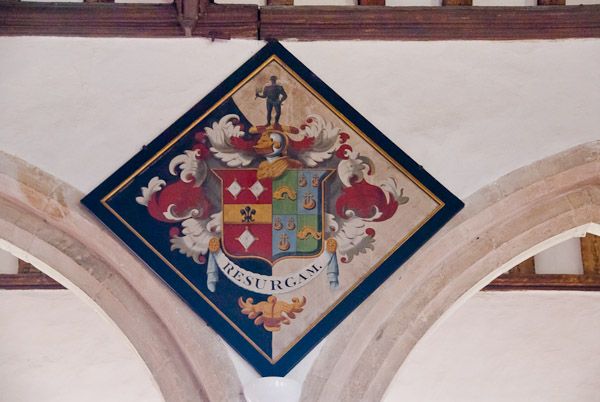Illustrated Dictionary of British Churches - Hatchment Definition
History and Architecture
- Aisle
- Altar
- Ambulatory
- Angel Roof
- Apophyge
- Apse
- Arcade
- Arch
- Archivolt
- Base
- Battlement
- Bay
- Belfry
- Bell Tower
- Bellcote
- Bench End
- Board Bell Turret
- Body
- Boss
- Box pew
- Bracket
- Broach Spire
- Buttress
- Canopy
- Capital
- Cartouche
- Chancel
- Chancel Arch
- Chancel Screen
- Chantry
- Chapel
- Chapter House
- Choir
- Clerestory
- Cloister
- Communion Rail
- Compound Column
- Consecration Cross
- Corbel Head
- Crossing
- Crypt
- Early English
- Easter Sepulchre
- Effigy
- Fan Vaulting
- Font
- Font cover
- Funerary Helm
- Gallery
- Gargoyle
- Gothic
- Green Man
- Grotesque
- Hatchment
- Herringbone
- Hogback Tomb
- Holy Water Stoup
- Hunky Punk
- Jesse Window
- Kempe Window
- Lady Chapel
- Lancet
- Lectern
- Lierne
- Lych Gate
- Misericord
- Monumental Brass
- Mullion
- Nave
- Ogee
- Organ
- Parclose Screen
- Parish Chest
- Pendant
- Perpendicular Gothic
- Pew
- Pinnacle
- Piscina
- Poor Box
- Poppy Head
- Porch
- Priest's Door
- Pulpit
- Purbeck Marble
- Quire
- Rebus
- Reliquary
- Reredos
- Retable
- Romanesque
- Rood
- Rood Loft
- Rood screen
- Rood Stair
- Rose Window
- Round Tower
- Sanctuary
- Sanctuary Knocker
- Saxon Period
- Scratch Dial
- Sedilia
- Spire
- Statue Niche
- Stoup
- Tomb Recess
- Tracery
- Transept
- Triforium
- Tympanum
- Undercroft
- Vaulting
- Victorian Gothic
- Wall Monument
- Wall Painting
- Wheel Window
Hatchment
A hatchment is a large coat of arms, usually painted on a wood and canvas frame, erected over the door of a deceased person's house after their death. Hatchments are usually diamond shaped, like a square turned 45 degrees to one side. The hatchment stayed in place for one year, after which it was moved to the parish church where it was usually hung on a wall. Hatchments were used in Britain from the 17th century, and the last recorded use was in 1942 at Over Kellet church in Lancashire. Some churches display numerous hatchments spanning centuries of local gentry families and thus are a good source of information about local history. Look for hatchments over nave arcades or on the walls of transepts.
Very specific rules governed the form and colour of hatchment decoration. For example, if the deceased was a bachelor the ground (background) was black, while if he was married his arms were set on a shield, impaled on those of his wife. If the deceased was the last of a line (i.e. there were no heirs) a Death's Head, or human skull, was shown. By studying the arms and colurs of the heraldic symbols and ground you can often guess the sex, social status, and in some cases even the name, of the deceased. Scottish hatchments often depict the arms of the mother, father, and grandparents as well as the deceased person.
Related: Nave



